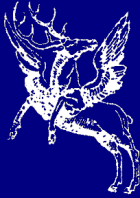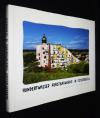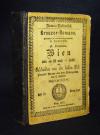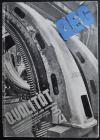Propaganda
Die Liste enthält 7 Einträge. Suchergebnisse löschen und Gesamtbestand anzeigen.
| Abbildung |
Beschreibung Gesamte Buchaufnahme |
Preis EUR |
|
|---|---|---|---|
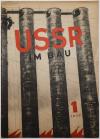 |
Pjatakov, G(eorgi Leonidowitsch, Editor in Chief). USSR in construction. – URSS en construction. Illustrated monthly magazine. – Revue mensuelle illustrée. – Year 1930 – 1937. – Année 1930 – 1937. 84 issues in 7 volumes and 12 issues unbound (1935). Moscow, State Publishing House of the RSFSR 1930-1937. Folio (43 x 30 cm.). With numerous illustrations and fold-out plates Contemporary linen bindings with gold-embossed spine titles (illustrated covers bound in, cover designs and layout by El Lissitzky, Aleksandr Rodchenko and others).
Hellyer 860. Karasik/Heiting 17 ff. Rowell/Wye 242 f. – The first eight volumes of the most important Soviet propaganda magazine. The volumes from 1930 to 1934 are in English and those from 1935 to 1937 are in French; the 1935 volume is available in individual issues. The magazine was published monthly from 1930 to 1949 in five languages (Russian, English, French, Spanish and German). Each issue was dedicated to a different subject, such as food and industrial production, the republic of Georgia, Soviet cinema and elections. – „In the early 1930s photo-reportage became the foundation of the magazine USSR in Construction that „was created as a publication for the popularization of large-scale construction projects by photographic means. But as the magazine grew and developed, the task of ‘popularization’ evolved into that of presenting Socialist reality with dramatic artistry.“ (L. Mezhericher, „Na putiakh k sotsialisticheskomu stiliu fotografii” [“On the way to a Socialist style of photography“], No. 2, p. 14). Well known Soviet designers and photographers worked on USSR in Construction. The industrial spirit of the magazine, expressed in compositionally sharp subjects, panoramas and dynamic shots evokes admiration even today and conveys the atmosphere of enthusiasm that carried along not just the photographers, but also the builders themselves. The creative scale of the construction engendered the photographic epic, a style of monumental artistic photography. The founders of this most successful and high-quality periodical were Gorky and Koltsov“ (Mikhail Karasik). – Binding slightly rubbed, otherwise in very good condition except for slight signs of wear and age. Schlagwörter: Avantgarde, Magazines, Propaganda, Soviet Union, Zeitschriften |
24.000,-- |  |
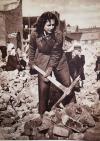 |
Puhlmann, Gerhard, (Max Ittenbach) u. a. Die Stalinallee. Nationales Aufbauprogramm 1952. Berlin, Verlag der Nation 1952. 4°. [102] Bl. mit 286 Abbildungen, 3 Fotomontagen und Illustrationen. Orig.-Halbleinenband.
Parr/Badger I, 182. – Erste Ausgabe des seltenen Propaganda-Fotobuchs über die Berliner Prachtstraße. – Das Werk „sollte einen Beitrag dazu leisten, die Überlegenheit des Sozialismus darzustellen und zeigen, wie der sozialistische Staat für die Arbeiterklasse sorgt, indem großzügig anspruchsvolle Wohnungen gebaut werden. Das Entstehen der Straße sollte ursprünglich nur filmdokumentarisch begleitet werden. Da Gerhard Puhlmann aber den Architekten Professor Hermann Henselmann persönlich kannte, verantwortlich für die Wohnbebauung am Strausberger Platz und den ersten Abschnitt der Stalinallee, sicherte er sich den Auftrag für die fotografische Begleitung des gesamten Bauvorhabens und konnte so die ganze Bandbreite seines Könnens auf brillante Weise unter Beweis stellen. Die hohe Qualität von Puhlmanns Arbeit an diesem Projekt wurde geehrt mit dem Nationalpreis 1. Klasse, verbunden mit einem Geldpreis von 100.000 Mark. 1953 betrug das durchschnittliche Monatseinkommen in der DDR laut Rententabelle 324 Mark“ (Zu einer Neuausgabe im Berlin Story Verlag 2022). – „Propaganda-Fotobücher gibt es in allen Formen, Größen und Ideologien. Manchmal erzählen sie Halbwahrheiten, manchmal lügen sie unverhohlen, manchmal sind sie so sachlich wie Unternehmensberichte. Gerhard Puhlmanns fotografische Dokumentation des viel gepriesenen Wiederaufbauprojekts der DDR gehört zwar eindeutig zur letzteren Kategorie, den harmlosesten Propagandabüchern, lobt aber dennoch eindeutig die Vorzüge des Vorhabens. Die Stalinallee, die 1961 (als Stalins Name in Ungnade fiel) in Frankfurter Allee und Karl-Marx-Allee umbenannt wurde, war das wichtigste städtebauliche Projekt, das in Ost-Berlin durchgeführt wurde. Dieser riesige, 75 bis 80 Meter breite Ost-West-Boulevard endete am Alexanderplatz, dem Zentrum des sowjetisch besetzten Berlins. Entworfen von einem Team unter der Leitung des ostdeutschen Architekten Heinrich Henselmann, war es ein äußerst ehrgeiziges Projekt, dessen erste Phase in Puhlmanns Buch liebevoll dokumentiert wurde“ (M. Parr). – Sehr gutes sauberes Exemplar. Schlagwörter: Berlin, Propaganda, Städtebau |
280,-- |  |
 |
(Hou Bo). Mao Tsetung. Photographien. (Zusammengestellt von Redaktion ’Photographie in China“). Peking, Verlag für Volkskunst und Verlag für Fremdsprachige Literatur (1978). Folio (38 x 32 cm.). [4] Bl., 200 Farbtafeln, [4] Bl. Roter Orig.-Leinenband mit goldgepr. Rücken- und Deckeltitel und Klarsicht-Schutzumschlag.
Parr/Badger I, 185 (engl. Ausgabe). Parr/Lundgren 248 ff. – Deutsche Ausgabe, geichzeitig erschienen noch Ausgaben in Chinesisch, Japanisch, Englisch, Spanisch und Französisch. – „While Hitler had his own personal photographer in Heinrich Hoffmann, Mao Zedong had Xu Xiaobing and his wife, Hou Bo, who took the photographs in this book. She was Mao’s official portrait photographer from 1950 until 1962, when she aroused the ire of the Chairman’s fearsome wife, Jiang Jing, and was sent to a labour camp on the orders of this future member of the Gang of Four. … Looking at some of the superb, iconic images in this fascinating book, which was published in many languages, it seems incredible that the official reason for Bo’s fall from grace was the allegation that she had never taken a good photograph of the Chairman. The real reason, it appears, was quite the opposite. Madame Jing wanted to monopolize Hou Bo’s photographic talents for her own aggrandizement, and when the photographer refused, she spent three hard years in a labour camp, emerging almost blind, and then spent a further seven years before her rehabilitation working as a cleaner for the New China Press Agency“ (Martin Parr in Parr/Badger). – „The adult life of Mao Zedong (Tsetung) is chronicled here in full-page, full-color portraits. Clearly posed for the traits. Clearly posed for the camera on the whole, the photographs show Mao as charismatic leader, teacher, thinker, general, and father figure. The backgrounds are highly stylized, pointing to some manipulation of the images, The purpose of this album, published two years after Mao’s death is to glorify Mao. The book reveals nothing about him that was not already known, but it reveals quite a lot about publishing and personality cults. Aside from a brief, unsigned preface, simple captions, and an index, the album has no text-the photos were, after all, self-explanatory, oft-published images. … As Mao aged and became more rotund, and as his hair receded, his facial skin retained its youthful color and glow, an attribute due less to nature than to artistic skill. The public’s mourning for Mao made books such as this one enormously popular, and ownership of a copy would have demonstrated a person’s loyalty to all that Mao represented in his quest to build a new China. The Red Sun That Never Sets finally set, but it continues to shine in books such as this“ (R. Lum in Parr/Lundgren). – Sehr schönes Exemplar. Schlagwörter: China, Mao, Tse-tung, Portrait photography, Portraitphotographie, Porträtfotografie, Porträtphotographie, Propaganda |
600,-- |  |
 |
Lissitzky, El (Book-Design). SSSR stroit Sotsializm. USSR baut den Sozialismus. – URSS construit le Socialisme. – USSR builds the Socialism. (Technical Editer: Alexander Brodsky). Moscow, IZOGIZ (printed by Ivan Fiodorov, Leningrad) 1933. Folio (34,5 x 26 cm.). XXVI, 284, (2) S. mit 2 Portrait-Tafeln und teils ganz- und doppelseitigen Abbildungen nach Fotografien und Foto-Montagen. Orig.-Halbleinenband mit silbergepr. Rückentitel, soviet. Flagge und zweifarb. Titel auf dem Vorderdeckel.
Heiting/Karasik 190 ff. – Einzige Ausgabe des wichtigen Propaganda-Albums. – „The year 1933 saw the publication of El Lissitzky’s first propaganda album – The USSR Is Building Sociaism, a visual chronicle, a pictorial report on the results of the first Five-Year Plan, an account of victories in the main fields of Socialist construction. The book opens with the text of Stalin’s reporton „The Results of the First Five-Year Plan” on pages VII-XVI (numbered with Roman numerals). In 1933 dozens of books were printed with this title. Three of them were designed by Varvara Stepanova, Solomon Telingater and Boris Titov. In this book there follow (on pages numbered from 1 with Arabic numerals) sections devoted to achievements in the leading branches of industry – mining, heavy industry, machine-building, ag riculture, and the main spheres of life – health services, culture, sport. The technical details about the publication are reduced to a minimum and placed at the start, on the reverse side of the endpaper. There is some interesting information „From the publishing house“: „The textual material and figures end with the editing of August 1932“ – the book was sent for setting in May and went to press in September 1932, so the data included were very much up-to-date. In 1933 statistics, like photography, still reflected the real state of affairs. By 1937 the situation had changed – figures became one of the elements of propaganda, while photography was stripped of the specifics of time and place. … The USSR Is Building Socialism is one of El Lissitzky’s first successful book projects in collaboratio n with IZOGIZ. From 1932 to May 1941 he was actively involved in the creation of the magazine USSR in Construction [SSSR na stroike] that was published by IZOGIZ. As one of the leading artist-designers, he prepared 19 issues and to a large extent determined the look of the magazine. The album The USSR Is Building Socialism is a sort of digest of the first issues of the magazine and includes a large proportion of photographs that had already been published. Many pictures became raw material for photomontages. The montage principle of presenting photographs practically supplanted individual shots: they are nearly all “knocked together“ in pairs along one edge, forming new compositions. The most original are the compositions on the double-page spreads. In them Lissitzky reveals himself to be a master of the photo-projection method of photomontage. The montage principle for the presentation of the material excludes the need to attribute the photographs, but many of them are recognizable. The photographs of Dneprostuoi, also published in USSR in Construction, were the work of Max Alpert, with whom Lissitzky made a special trip to the site of the hydro-electric project; the shots of the Donbas by Yeleazar Langman; those of the Magnitogorsk complex by Anatoly Skurikhin; those of Kuznetskstroi by Pavel Zhukov, Mikhail Kalashnikov and M. Prigozhin. The album ends with a photograph of a military man, one of the heroes of the skiing trek in a Budionny cap and greatcoat dusted with snow – this image, popular with the magazines of th e period, was the work of Arkady Shaikhet. It is a curious fact that while he continued to practice photography in the 1930s, when it had lost its experimental character, Lissitzky in contrast to Rodchenko hardly ever used his own pictures in books. The construction of the album is founded upon the magazine principle – a compilation of issues. The development of the visual blocks is accentuated by the double-page photomontages printed in two colours, black and red. The introduction of short slogan-like texts into the photomontages make these pages look like posters“ (M. Karasik). – Deckel etwas angestaubt und leicht fleckig, nur vereinzelt um Blattrand geringfügig braunfleckig, sehr gutes Exemplar. Schlagwörter: Avantgarde, Propaganda, Russland, Soviet Union, Sozialismus |
7.500,-- |  |
 |
Lucas, Robert. Teure Amalia, vielgeliebtes Weib. Die Briefe des Gefreiten Adolf Hirnschal an seine Frau in Zwieselsdorf. Zürich, Europa Verlag (1945). 8°. 188 S. mit Illustrationen im Text. OLn.
Exilarchiv 3550. Sternfeld-Tiedemann 321. – Erste Ausgabe, erschien zeitgleich auch in Wien. – Sehr gutes Exemplar. Schlagwörter: Exilliteratur, Propaganda, Satire, Weltkrieg <1939-1945>, Weltkrieg II, Zweiter Weltkrieg |
40,-- |  |
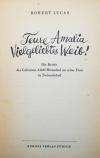 |
Lucas, Robert. Teure Amalia, vielgeliebtes Weib. Die Briefe des Gefreiten Adolf Hirnschal an seine Frau in Zwieselsdorf. Zürich, Europa Verlag (1945). 8°. 188 S. mit Illustrationen im Text. OLn. u. illustr. OU.
Exilarchiv 3550. Sternfeld-Tiedemann 321. – Erste Ausgabe, erschien zeitgleich auch in Wien. – Mit eigenhändiger Widmung und maschinenschr. Brief von R. Lucas an den Schweizer Rundfunk-Intendanten Erwin Roth (dat. 11. August 1979). – Auswahl aus den von der BBC London während der Kriegsjahre 1940-45 gesendeten „Briefen des Gefreiten Hirnschal“. – Einband leicht fleckig, vorderes freies Vorsatzblatt fehlt, sonst gut erhalten. Schlagwörter: Autographen, Exilliteratur, Propaganda, Satire, Signierte Bücher, Weltkrieg <1939-1945>, Weltkrieg II, Widmungsexemplar, Zweiter Weltkrieg |
180,-- |  |
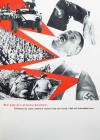 |
Illek & Paul, Karel Hájek, O. Stanek, K. Parik – Fierlinger, Z(denek), Václav Kopecky, B. Nemec u. a. Košický vládni Program. Program nové Ceskoslovenské vlády národni fronty cechu a slovaku. Prijaty na prvé schuzi vlády dne 1. dubna 1945 v Kosicich Praha (Prag), Svet v Obrazech (1945). 4°. [44] Bl. mit 18 (17 ganzs.) Foto-Montagen, meist in Rot und Schwarz. Farbig illustr. Orig.-Kartonumschlag.
Heiting, Czech and Slovak Photo Publikations 266. – Orig.-Ausgabe des seltenen Propagandawerks der neuen tschechischen Regierung anlässlich der Beendigung der nationalsozialistischen Besetzung durch deutsche Truppen und des deutschen Protektorats Böhmen und Mähren. „Bereits am 21. Oktober 1938 hatte Hitler die Wehrmacht angewiesen, sich auf die „Erledigung der Rest-Tschechei“ vorzubereiten. Nach einem deutschen Ultimatum erklärte sich die Slowakei am 14. März 1939 für unabhängig (Slowakischer Staat). Am nächsten Tag erreichte Hitler durch die Androhung einer Bombardierung Prags, dass der bisherige tschechoslowakische Staatspräsident Emil Hácha sein Land „dem Schutz des Deutschen Reiches“ unterstellte“ (Wikipedia). – Die interessanten an J. Heartfield oder Rodtschenko erinnernden Fotomontagen wurden unter Verwendung von Aufnahmen von Alexandr Paul (1907-1981) und Frantisek Illek (1904-1969), (Illek & Paul), Karel Hájek (1900-1978), O. Stanek, K. Parik und Pressefotos gestaltet. – Rücken u. vord. Gelenk etwas berieben, sehr gutes Exemplar. – Original edition of the rare propaganda work of the new Czech government on the occasion of the end of the National Socialist occupation by German troops and the German Protectorate of Bohemia and Moravia. “On October 21, 1938, Hitler had already instructed the Wehrmacht to prepare for the “liquidation of the rest of Czechoslovakia”. Following a German ultimatum, Slovakia declared itself independent (Slovakian state) on March 14, 1939. The next day, by threatening to bomb Prague, Hitler succeeded in getting the previous Czechoslovak President Emil Hácha to place his country “under the protection of the German Reich” (Wikipedia). – The interesting photomontages, reminiscent of J. Heartfield or Rodchenko, were created using photographs by Alexandr Paul (1907-1981) and Frantisek Illek (1904-1969), (Illek & Paul), Karel Hájek (1900-1978), O. Stanek, K. Parik and press photos. – Spine and front hinge somewhat rubbed, very good copy. Schlagwörter: Fotomontage, Nationalsozialismus, Propaganda, Tschechoslowakei, Weltkrieg <1939-1945> |
650,-- |  |
|
Einträge 1–7 von 7
Zurück · Vor
|
|||
| Seite: 1 |

